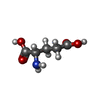[English] 日本語
 Yorodumi
Yorodumi- PDB-4nf4: Crystal structure of GluN1/GluN2A ligand-binding domain in comple... -
+ Open data
Open data
- Basic information
Basic information
| Entry | Database: PDB / ID: 4nf4 | ||||||
|---|---|---|---|---|---|---|---|
| Title | Crystal structure of GluN1/GluN2A ligand-binding domain in complex with DCKA and glutamate | ||||||
 Components Components |
| ||||||
 Keywords Keywords | transport protein / receptor / DCKA and glutamate | ||||||
| Function / homology |  Function and homology information Function and homology informationneurotransmitter receptor transport, plasma membrane to endosome / regulation of response to alcohol / response to ammonium ion / receptor recycling / directional locomotion / pons maturation / response to environmental enrichment / positive regulation of Schwann cell migration / regulation of cell communication / EPHB-mediated forward signaling ...neurotransmitter receptor transport, plasma membrane to endosome / regulation of response to alcohol / response to ammonium ion / receptor recycling / directional locomotion / pons maturation / response to environmental enrichment / positive regulation of Schwann cell migration / regulation of cell communication / EPHB-mediated forward signaling / auditory behavior / Assembly and cell surface presentation of NMDA receptors / response to hydrogen sulfide / olfactory learning / conditioned taste aversion / dendritic branch / regulation of respiratory gaseous exchange / serotonin metabolic process / response to other organism / protein localization to postsynaptic membrane / regulation of ARF protein signal transduction / cellular response to magnesium ion / transmitter-gated monoatomic ion channel activity / positive regulation of inhibitory postsynaptic potential / suckling behavior / response to methylmercury / sleep / response to glycine / propylene metabolic process / response to carbohydrate / response to manganese ion / dendritic spine organization / locomotion / regulation of NMDA receptor activity / cellular response to dsRNA / cellular response to lipid / regulation of monoatomic cation transmembrane transport / NMDA glutamate receptor activity / Synaptic adhesion-like molecules / RAF/MAP kinase cascade / voltage-gated monoatomic cation channel activity / response to glycoside / NMDA selective glutamate receptor complex / neurotransmitter receptor complex / ligand-gated sodium channel activity / glutamate binding / glutamate receptor signaling pathway / response to morphine / calcium ion transmembrane import into cytosol / regulation of axonogenesis / neuromuscular process / regulation of dendrite morphogenesis / protein heterotetramerization / male mating behavior / glycine binding / regulation of synapse assembly / spinal cord development / response to amine / parallel fiber to Purkinje cell synapse / cellular response to zinc ion / startle response / positive regulation of reactive oxygen species biosynthetic process / monoatomic cation transmembrane transport / dopamine metabolic process / response to lithium ion / positive regulation of calcium ion transport into cytosol / modulation of excitatory postsynaptic potential / response to light stimulus / regulation of postsynaptic membrane potential / regulation of neuron apoptotic process / associative learning / cellular response to glycine / action potential / monoatomic cation transport / conditioned place preference / excitatory synapse / positive regulation of dendritic spine maintenance / social behavior / regulation of neuronal synaptic plasticity / monoatomic ion channel complex / positive regulation of protein targeting to membrane / positive regulation of excitatory postsynaptic potential / glutamate receptor binding / Unblocking of NMDA receptors, glutamate binding and activation / long-term memory / positive regulation of synaptic transmission, glutamatergic / synaptic cleft / multicellular organismal response to stress / neuron development / prepulse inhibition / postsynaptic density, intracellular component / phosphatase binding / monoatomic cation channel activity / calcium ion homeostasis / response to fungicide / glutamate-gated receptor activity / cell adhesion molecule binding / glutamate-gated calcium ion channel activity / cellular response to manganese ion / presynaptic active zone membrane Similarity search - Function | ||||||
| Biological species |  | ||||||
| Method |  X-RAY DIFFRACTION / X-RAY DIFFRACTION /  SYNCHROTRON / SYNCHROTRON /  MOLECULAR REPLACEMENT / Resolution: 2 Å MOLECULAR REPLACEMENT / Resolution: 2 Å | ||||||
 Authors Authors | Annie, J. / Tajima, N. / Furukawa, H. | ||||||
 Citation Citation |  Journal: Neuron / Year: 2014 Journal: Neuron / Year: 2014Title: Structural Insights into Competitive Antagonism in NMDA Receptors. Authors: Jespersen, A. / Tajima, N. / Fernandez-Cuervo, G. / Garnier-Amblard, E.C. / Furukawa, H. | ||||||
| History |
|
- Structure visualization
Structure visualization
| Structure viewer | Molecule:  Molmil Molmil Jmol/JSmol Jmol/JSmol |
|---|
- Downloads & links
Downloads & links
- Download
Download
| PDBx/mmCIF format |  4nf4.cif.gz 4nf4.cif.gz | 142.2 KB | Display |  PDBx/mmCIF format PDBx/mmCIF format |
|---|---|---|---|---|
| PDB format |  pdb4nf4.ent.gz pdb4nf4.ent.gz | 108 KB | Display |  PDB format PDB format |
| PDBx/mmJSON format |  4nf4.json.gz 4nf4.json.gz | Tree view |  PDBx/mmJSON format PDBx/mmJSON format | |
| Others |  Other downloads Other downloads |
-Validation report
| Summary document |  4nf4_validation.pdf.gz 4nf4_validation.pdf.gz | 465.9 KB | Display |  wwPDB validaton report wwPDB validaton report |
|---|---|---|---|---|
| Full document |  4nf4_full_validation.pdf.gz 4nf4_full_validation.pdf.gz | 473 KB | Display | |
| Data in XML |  4nf4_validation.xml.gz 4nf4_validation.xml.gz | 34.2 KB | Display | |
| Data in CIF |  4nf4_validation.cif.gz 4nf4_validation.cif.gz | 49.3 KB | Display | |
| Arichive directory |  https://data.pdbj.org/pub/pdb/validation_reports/nf/4nf4 https://data.pdbj.org/pub/pdb/validation_reports/nf/4nf4 ftp://data.pdbj.org/pub/pdb/validation_reports/nf/4nf4 ftp://data.pdbj.org/pub/pdb/validation_reports/nf/4nf4 | HTTPS FTP |
-Related structure data
- Links
Links
- Assembly
Assembly
| Deposited unit | 
| ||||||||
|---|---|---|---|---|---|---|---|---|---|
| 1 |
| ||||||||
| Unit cell |
|
- Components
Components
| #1: Protein | Mass: 33340.031 Da / Num. of mol.: 1 Fragment: Ligand-binding domain, unp residues 393-543; unp residues 663-800 Source method: isolated from a genetically manipulated source Source: (gene. exp.)   |
|---|---|
| #2: Protein | Mass: 31785.299 Da / Num. of mol.: 1 Fragment: Ligand-binding domain; unp residues 402-539; unp residues 661-802 Mutation: S758T Source method: isolated from a genetically manipulated source Source: (gene. exp.)   |
| #3: Chemical | ChemComp-2JK / |
| #4: Chemical | ChemComp-GLU / |
| #5: Water | ChemComp-HOH / |
| Has protein modification | Y |
-Experimental details
-Experiment
| Experiment | Method:  X-RAY DIFFRACTION X-RAY DIFFRACTION |
|---|
- Sample preparation
Sample preparation
| Crystal | Density Matthews: 2.48 Å3/Da / Density % sol: 50.42 % |
|---|---|
| Crystal grow | Temperature: 300 K / Method: vapor diffusion / pH: 7 Details: PEG2000MME, HEPES, pH 7, VAPOR DIFFUSION, temperature 300K |
-Data collection
| Diffraction | Mean temperature: 100 K |
|---|---|
| Diffraction source | Source:  SYNCHROTRON / Site: SYNCHROTRON / Site:  NSLS NSLS  / Beamline: X25 / Wavelength: 1 Å / Beamline: X25 / Wavelength: 1 Å |
| Detector | Type: ADSC QUANTUM 315r / Detector: CCD / Date: Oct 25, 2011 |
| Radiation | Protocol: SINGLE WAVELENGTH / Monochromatic (M) / Laue (L): M / Scattering type: x-ray |
| Radiation wavelength | Wavelength: 1 Å / Relative weight: 1 |
| Reflection | Resolution: 2→50 Å / Num. obs: 44333 / % possible obs: 99 % |
- Processing
Processing
| Software |
| |||||||||||||||||||||||||||||||||||||||||||||||||||||||||||||||||||||||||||||||||||||||||||||||||||||||||||||||||||||||
|---|---|---|---|---|---|---|---|---|---|---|---|---|---|---|---|---|---|---|---|---|---|---|---|---|---|---|---|---|---|---|---|---|---|---|---|---|---|---|---|---|---|---|---|---|---|---|---|---|---|---|---|---|---|---|---|---|---|---|---|---|---|---|---|---|---|---|---|---|---|---|---|---|---|---|---|---|---|---|---|---|---|---|---|---|---|---|---|---|---|---|---|---|---|---|---|---|---|---|---|---|---|---|---|---|---|---|---|---|---|---|---|---|---|---|---|---|---|---|---|---|
| Refinement | Method to determine structure:  MOLECULAR REPLACEMENT / Resolution: 2→19.903 Å / SU ML: 0.21 / σ(F): 1.38 / Phase error: 22.09 / Stereochemistry target values: ML MOLECULAR REPLACEMENT / Resolution: 2→19.903 Å / SU ML: 0.21 / σ(F): 1.38 / Phase error: 22.09 / Stereochemistry target values: ML
| |||||||||||||||||||||||||||||||||||||||||||||||||||||||||||||||||||||||||||||||||||||||||||||||||||||||||||||||||||||||
| Solvent computation | Shrinkage radii: 0.9 Å / VDW probe radii: 1.11 Å / Solvent model: FLAT BULK SOLVENT MODEL | |||||||||||||||||||||||||||||||||||||||||||||||||||||||||||||||||||||||||||||||||||||||||||||||||||||||||||||||||||||||
| Refinement step | Cycle: LAST / Resolution: 2→19.903 Å
| |||||||||||||||||||||||||||||||||||||||||||||||||||||||||||||||||||||||||||||||||||||||||||||||||||||||||||||||||||||||
| Refine LS restraints |
| |||||||||||||||||||||||||||||||||||||||||||||||||||||||||||||||||||||||||||||||||||||||||||||||||||||||||||||||||||||||
| LS refinement shell |
|
 Movie
Movie Controller
Controller





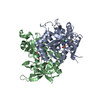
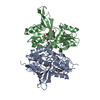



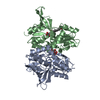
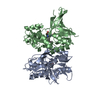
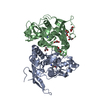
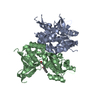

 PDBj
PDBj






